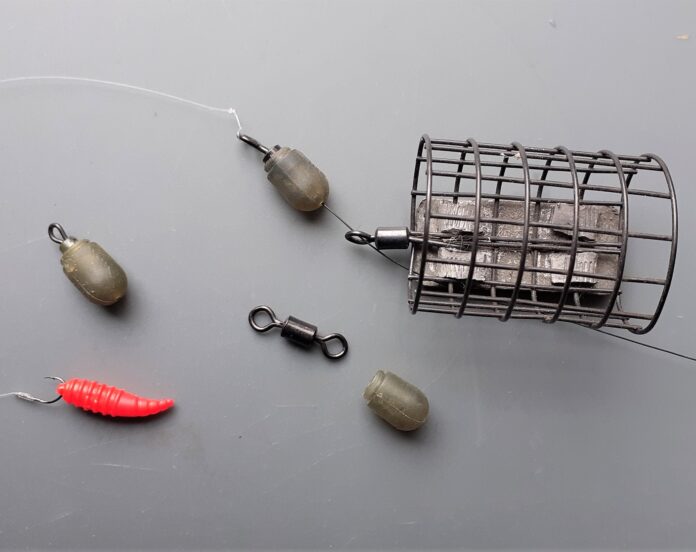MINI BEADS
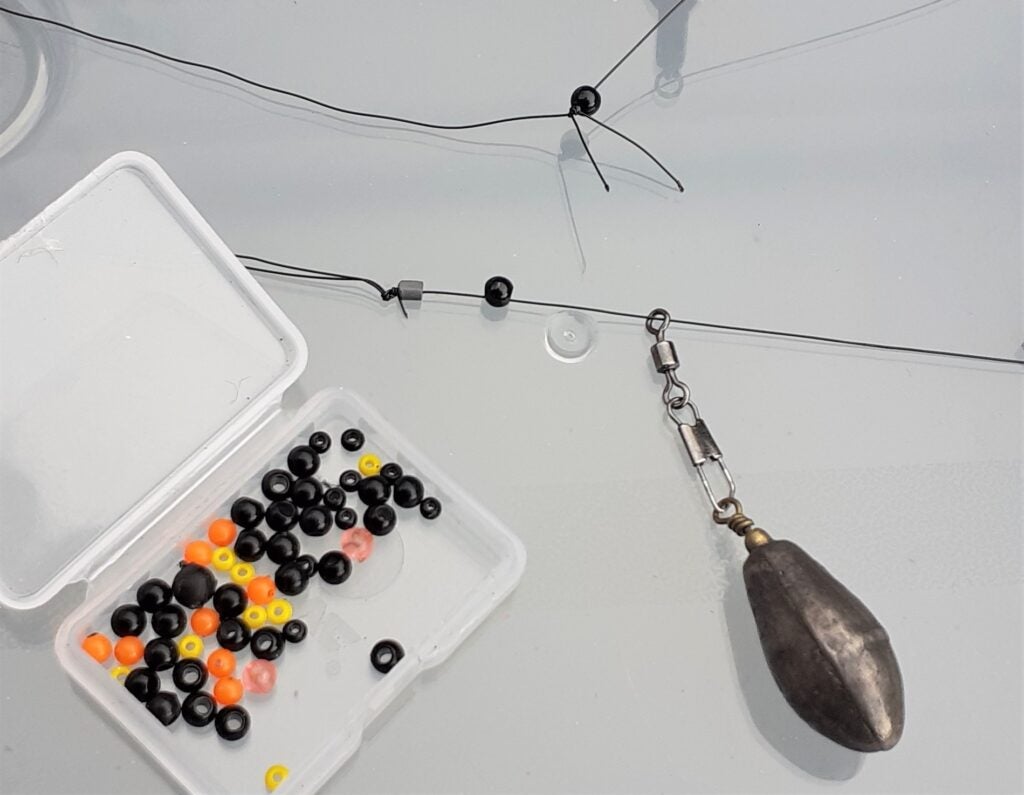

Small beads are ideal for slider fishing. I always thread one on the reel line between the float and stop knot, where it makes a great buffer, preventing the float’s base eye from over-running the correct depth setting. Another good trick with mini plastic beads is to have one or two on the main line when legering, positioned between a free-running bomb and whatever you use to stop it with. This helps to push the hooklength away, particularly if it’s positioned directly underneath the stopper. I use a small shot to prevent the leger weight from travelling onto the hooklength. My legers are often attached via an American snap swivel, which allows bomb sizes to be changed quickly, or even a switch to a small feeder. Slightly flattened micro beads can be bought cheap from retailers who sell knitting and sewing accessories, while most tackle shops sell small round beads that suit usage as buffers, normally found in the carp or sea sections.
MICRO SWIVELS
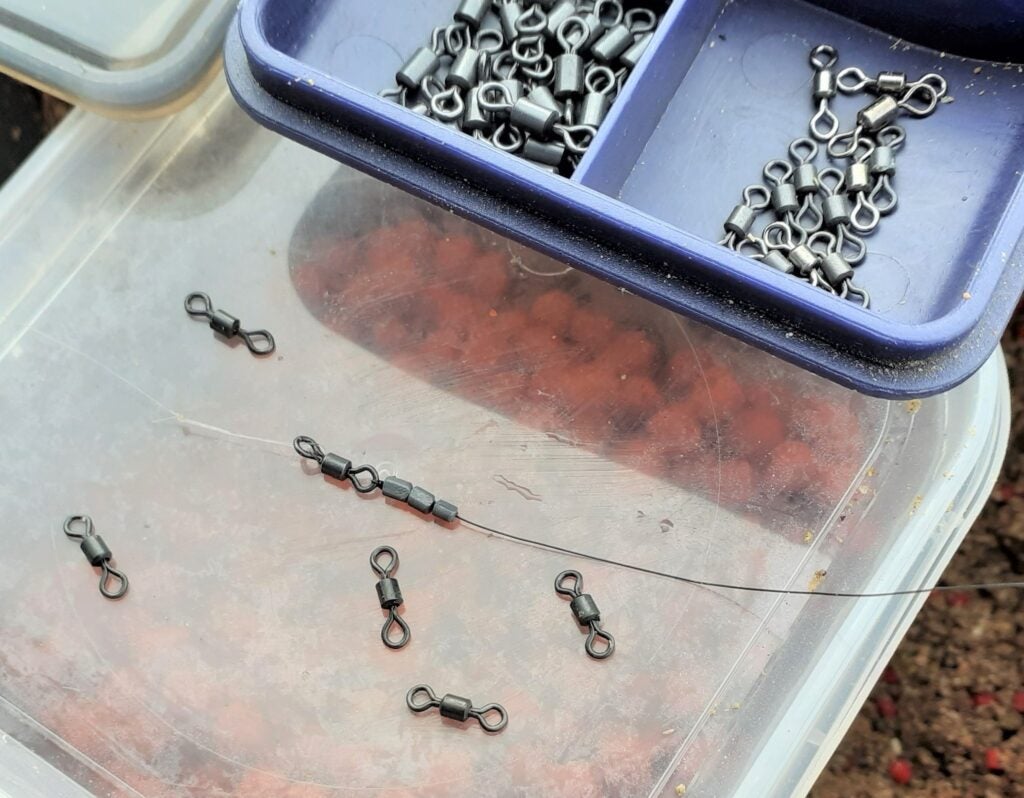

The best small swivels are normally found on the carp rig bits boards in tackle shops. Apart from being super-strong, most have an unobtrusive dull black finish, perfect for any item that is going to be positioned near the hook. I have two main tasks for micro swivels. With waggler tackle I always use them to join the reel line to thinner hooklength material. This gives a stronger union than any knot, also helping to prevent the trace line from spinning up when the tackle is retrieved. Again, for superior knot strength and to prevent line spin, the same tiny swivels are used on most of my standard feeder rigs. With groundbait designs, I like to have a micro swivel positioned at the end of a twizzled mono link. This is formed from the reel line, ending in the tiny swivel, to which a hooklength is attached. Stiff links like this prevent tangles, both when the feeder is cast out and while the end tackle is descending, particularly important in deep water pegs.
HOOKLENGTH SWIVELS
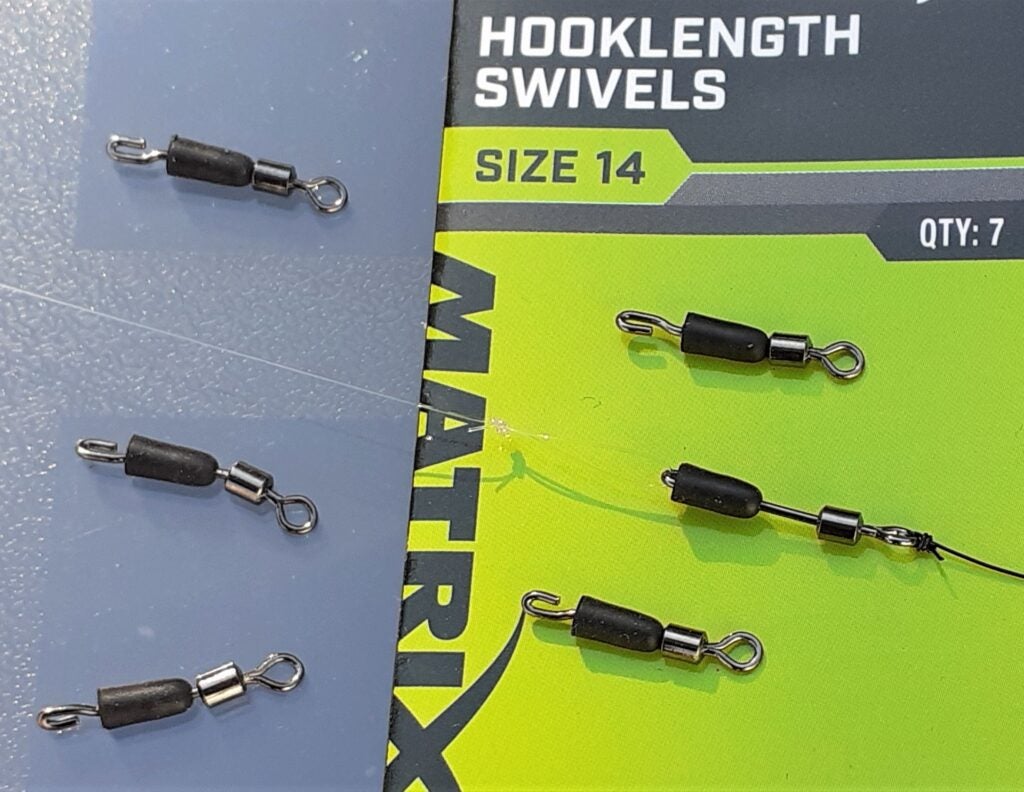

As mentioned previously, using a small swivel to attach a hooklength to the main line is a good way of preventing the finer trace material from twisting up and tangling. This smart move can now be taken a step further with specially designed Hooklength Swivels. Apart from preventing line spin, these clever gizmos have hooked leading ends, which a looped rig can quickly be attached to. A sliding rubber sleeve neatly locks everything in place. This quick-change facility allows line strengths and hook sizes to be switched in seconds, handy if something different is required, or if a replacement is needed. This new type of swivel can be used with float or feeder gear, being supplied in various sizes. The only applications I wouldn’t recommend them for are method, hybrid, or pellet feeders. They can jam up inside in-line models, plus with the strenuous demands these designs entail, I would worry that the locking sleeve might accidentally slip open.
QUICK CHANGE SWIVELS
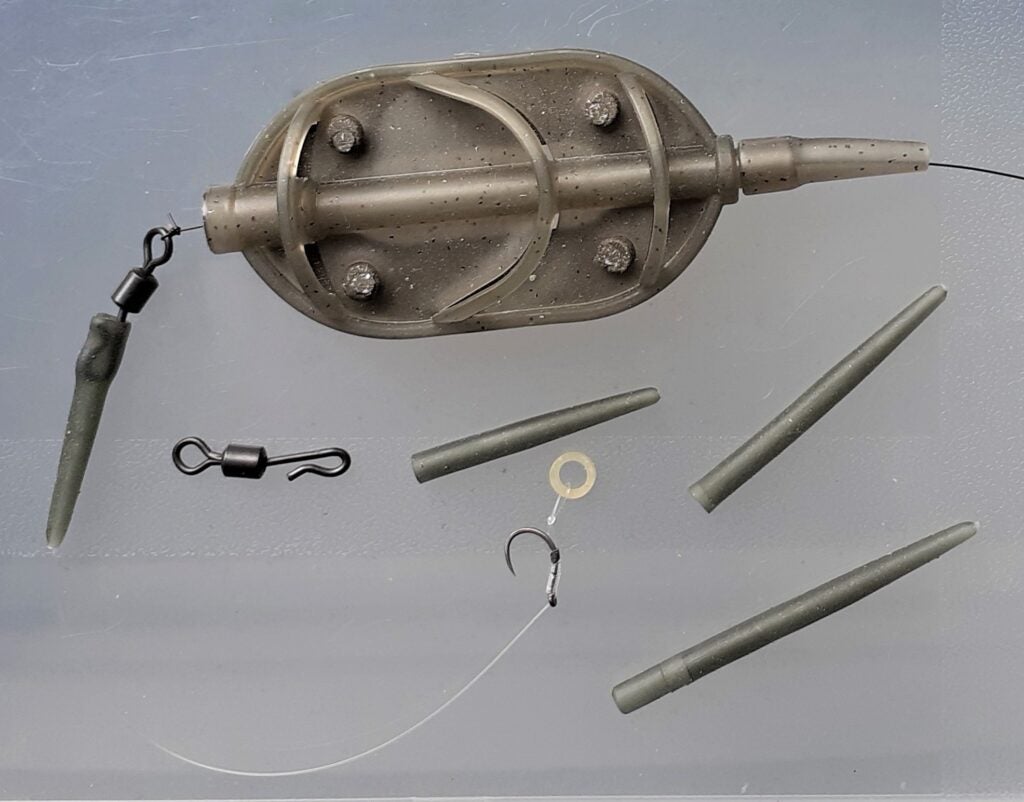

Q.C. Swivels are mostly used by carp and specimen anglers, but you can buy fairly small sizes and, combined with long tail rubbers, they do have their uses for general fishing. This format combines okay with in-line feeders, providing the swivel’s eye fits the bases of their tubes okay. The crooked part, which short traces and carp-style rigs can be attached to, is a bit more secure than the open nature of the Hooklength Swivels looked at previously. I was doing some work in France a couple of years ago, where carp fishing with method feeders is immensely popular. Q.C. swivels and long tail rubbers are often used with the method over there, when hook baits are being presented outside a loading of groundbait or micro pellets. We have all experienced short hooklengths wrapping back and tangling with in-line feeders on the cast, which this set-up helps to avoid. These swivels and long tails are popular for the freely rotating part of helicopter rigs too.
PROTECTOR SLEEVES
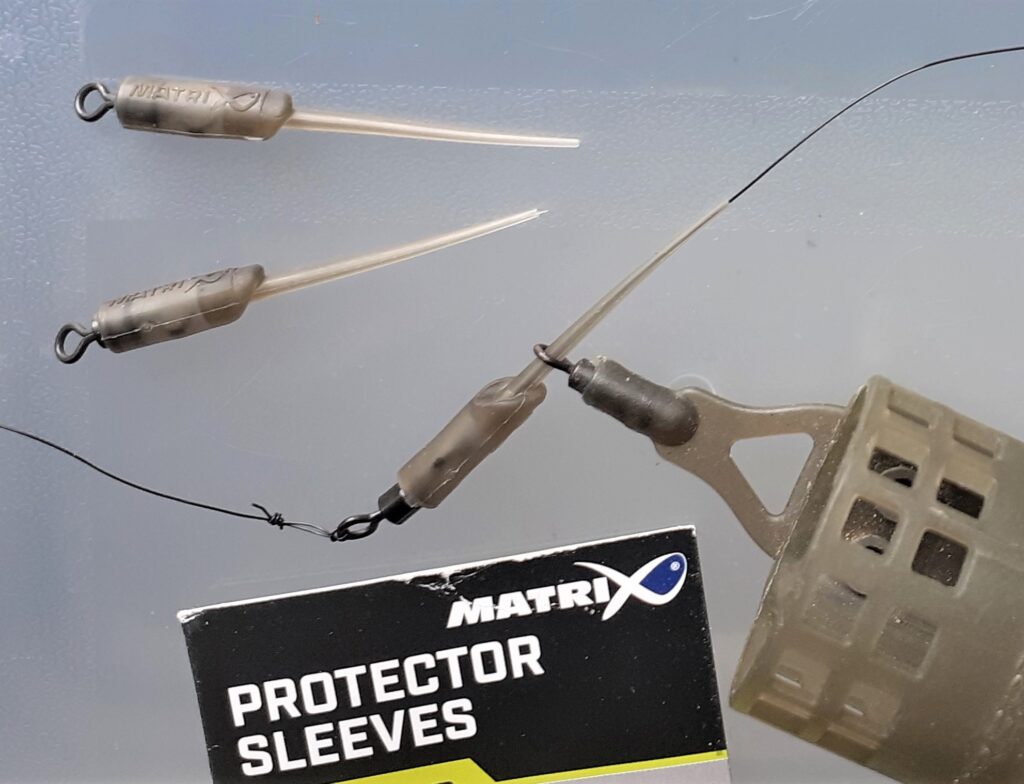

Matrix Protector Sleeves are a clever variation on the buffer bead concept, designed for heavy or long-range feeder fishing. With normal buffers, vigorous casting or a lot of weight hitting against them causes excess stress on the main line, which can eventually lead to crack-offs. But elongated and tapered Protector Sleeves allow the swivels on feeder links to smoothly run onto them, shielding the line and preventing the feeder from interfering with the hooklength. The latter is attached via one of the snug-fitting swivels that are part of this system, which also help to prevent line spin. This clever gizmo suits big chuck open-end feeder fishing when using medium to long hooklengths, also working well with weighty window feeders and shorter trace requirements. There are standard and small size options. The standard size is best for heavy-duty free-running feeders, while the smaller variation suits less demanding work, to help kick the hooklength away.
QUICK BEADS
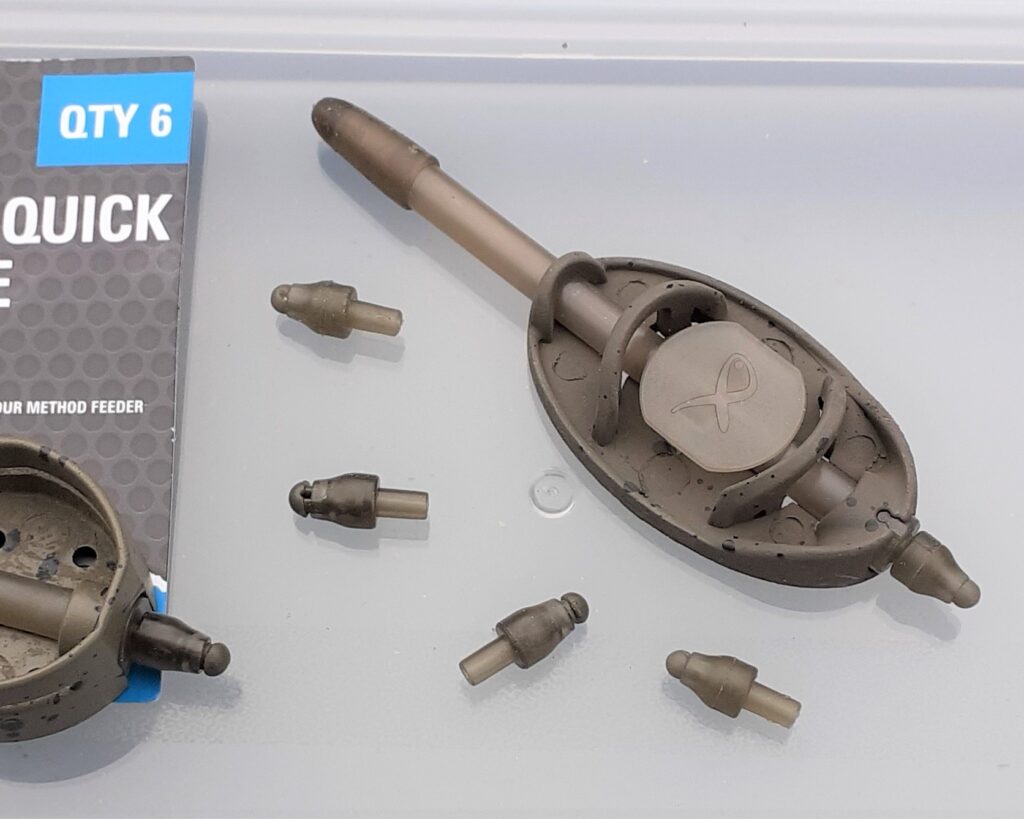

Quick Change or Speed Beads, as they are sometimes called, are a new development for method and hybrid feeder fishing. They offer two main advantages, allowing fast hooklength changes, but also helping to create a semi-fixed bolt rig effect. The latter occurs because unlike old-style method connectors, these beads have short stems, which snugly fit inside the leading end of the feeder’s in-line tube. This creates just enough resistance for a taking fish to feel the weight of the feeder, but as soon as this happens the bead pulls free, so the rig becomes free-running and safe. This new style of connector bead is also easier to operate than some of the older versions, which were tricky to open, especially when wanting to switch short hooklengths in a hurry. This new concept is hugely popular with match anglers, who often have spare hooklengths ready baited, saving valuable time during the course of competitions and resulting in catching vital bonus fish.
BUFFER BEADS
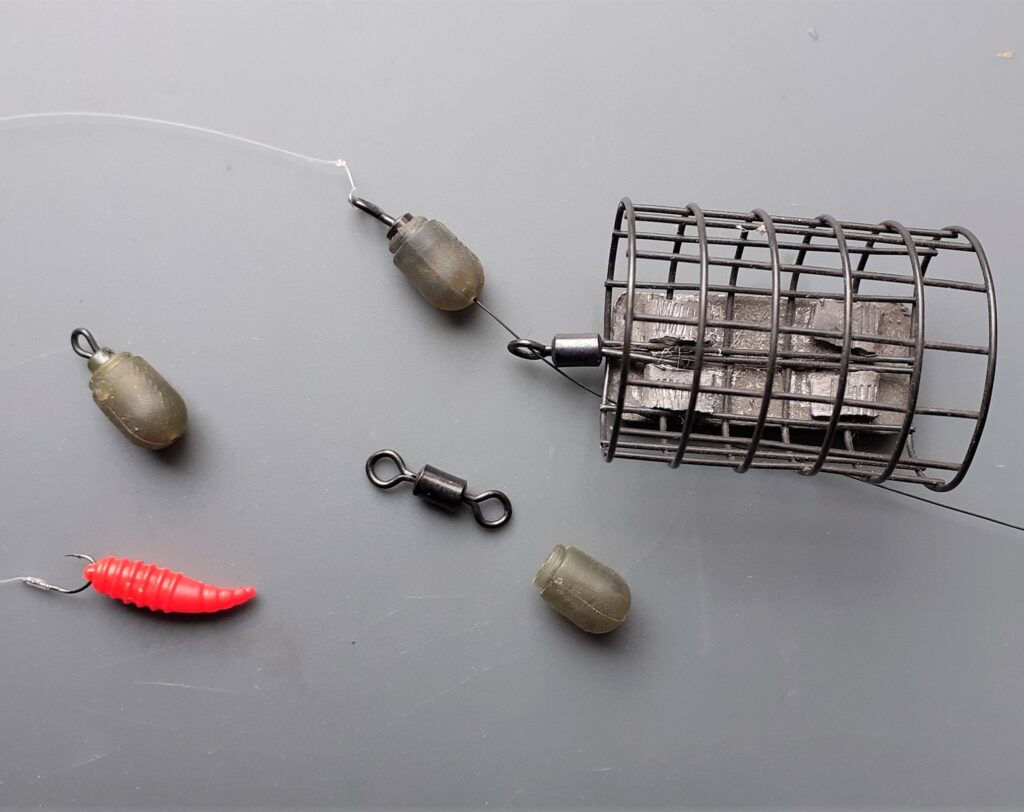

Buffer beads provide a simple way of setting up short-range feeder or leger rigs, using the rubber part as a cushioned stop and the swivel – that neatly pushes inside – to join the main line to the hooklength. When the weight of a feeder or bomb rests against the bead, it pushes the link away at an angle to prevent tangles, while the exposed half of the swivel prevents line twist with this set-up. Knot strength is improved too, especially if looped hooklengths are attached to the leading end of the swivel. A big tackle company I once worked for had a force-testing machine and I used to experiment with different ways of joining lines, discovering many traditional knots lessened the breaking strain of hooklength materials by up to 40%. However, by attaching heavier reel lines or shock leaders to thinner mono via any type of swivel, I normally achieved more than 90% of the stated B.S. With direct knots, thicker lines tend to strangle thinner ones.
FEEDER LINKS
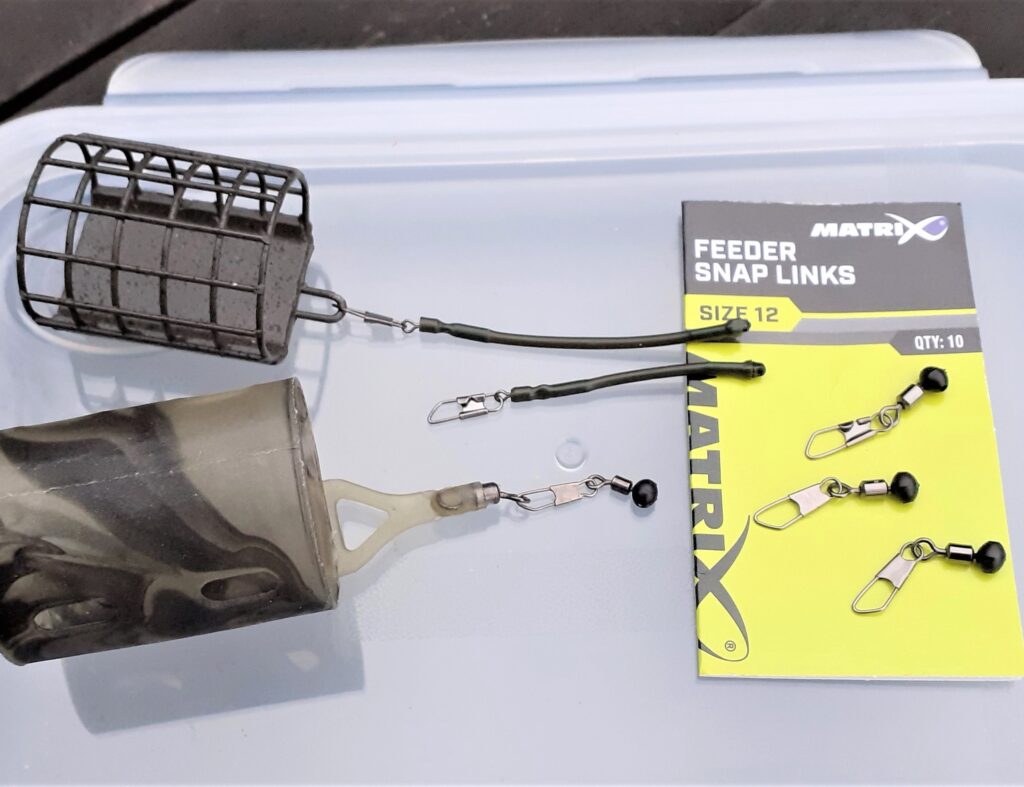

Short snap links fitted to free-running beads have largely replaced American Swivel Links as a means of attaching various feeder designs to rigs. The bead part runs more smoothly than a metal swivel, while the link still allows quick feeder changes, or a complete switch to leger weights, should you decide to stop putting bait into a swim for a while. It’s best to use these neat devices free-running to avoid tethering fish if the end tackle is lost. A popular set-up is to have a small stop shot anchored above a short twizzled boom at the end of the reel line, with the hooklength attached to the leading end. This creates a safe paternoster-style rig, perfect for most designs of feeder, also when switching to leger weights. I find beaded snap links work best with feeders that already have long links installed. However, for groundbait or blocked models that only feature short links, it’s better to use longer shrink tube covered booms, like the popular green Guru ones.
FEEDER BEADS
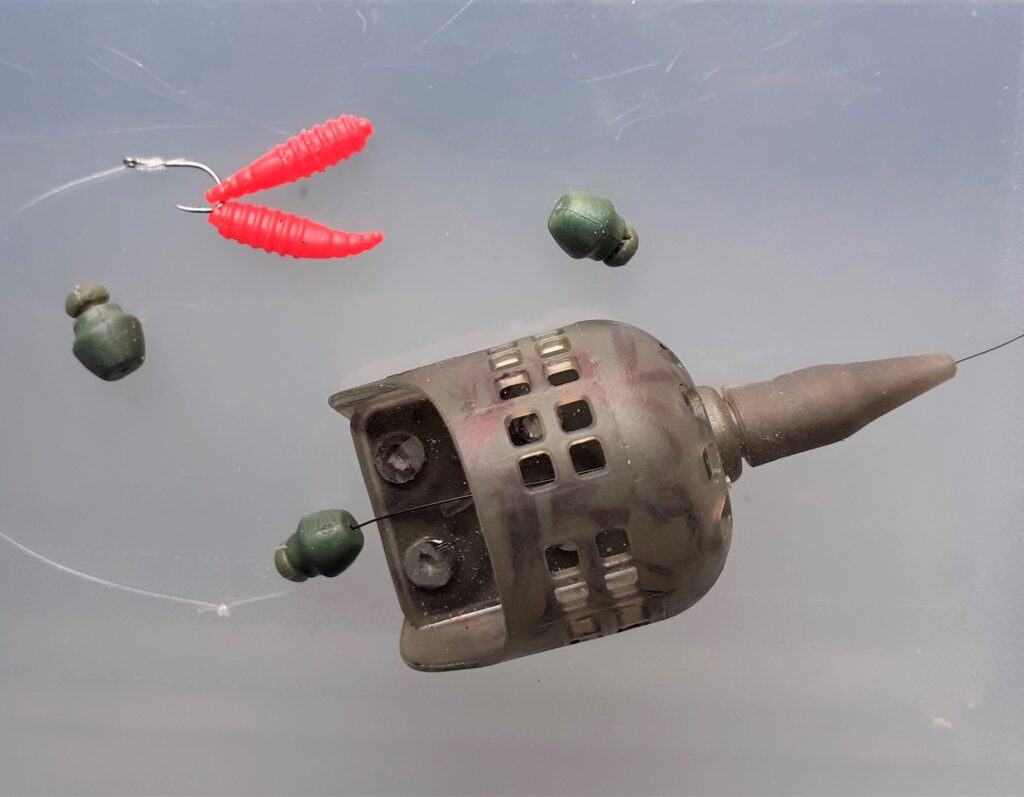

Compact feeder beads work well with pellet feeders, tucking neatly inside as the main line is tightened up, keeping rigs free-running. These unobtrusive connectors are used to join short hooklengths to main lines, allowing quick changes, if required. They can be used with other in-line designs like method or hybrid feeders, as an alternative to bolt rigs. Similar to swivels, connector beads create a much stronger union between thicker diameter reel line and lesser breaking strain trace materials. They allow short hooklengths to be switched quickly, useful for trying different mono strengths and hook sizes, or when pre-baiting reserve end rigs to save on valuable fishing time. I like to use camo or green connector beads, which blend in with most feeder colours. They act as good buffers with free-running set-ups and are okay to use on running water blockend feeder rigs, a good option when keeping things simple to avoid snagging over rough ground.
SWIVEL BEADS
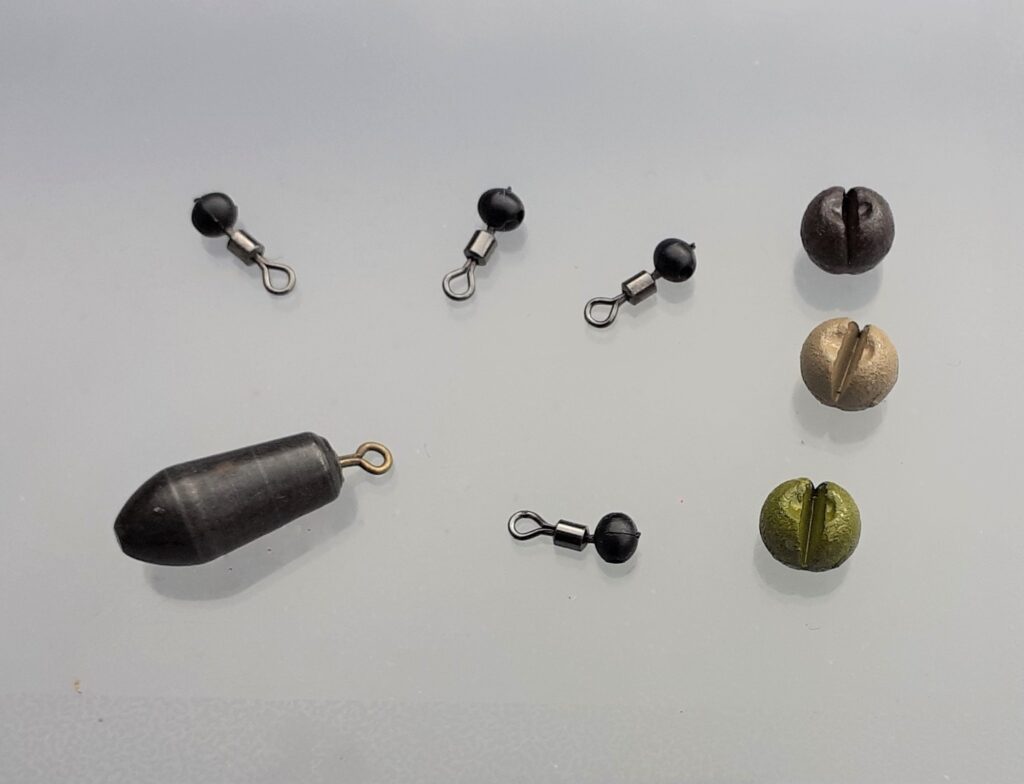

Swivel beads are useful components for making stiff links, which can be a vital part of forming leger rigs, either with a bomb or large split shot. They are much kinder when left free-running on the main line, compared to an all-metal swivel. Once the bead part hits a stop shot, it helps to push the hooklength away. Smaller swivel beads are good for forming helicopter rigs, while medium sizes are better for creating free-running paternoster-style set-ups, which are much safer than fixed versions. The nice thing about building a split shot link when legering, is you can get the tackle critically balanced. This tackle set-up seems to have largely been forgotten for river fishing and yet it’s deadly when targeting chub, big roach and barbel. By experimenting with the number and size of split shot, it’s possible to get rigs only just holding bottom. When anything interferes with the hook bait, the weight loses its grip and moves, causing classic drop-back bites.
LINE STOPS
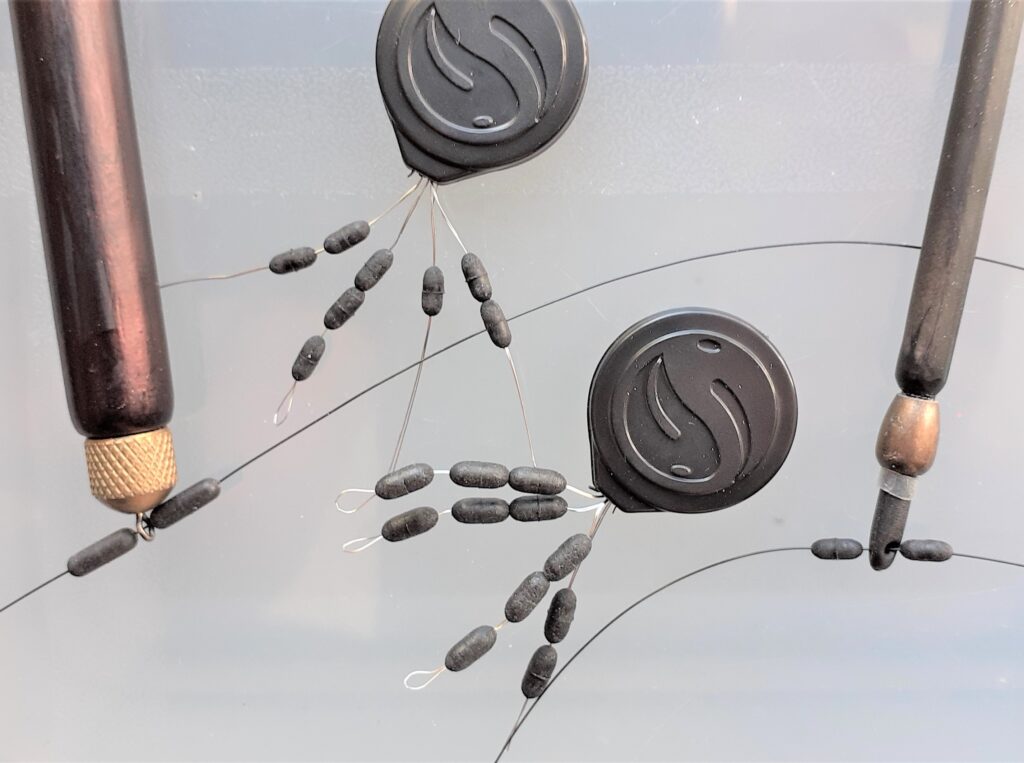

A new breed of rubber beads have become immensely popular over recent years, called line stops. These are supplied on wire loops for easy transfer onto mono. Line stops are available in many different shapes and sizes and have a wide range of uses. Mainly they are used to create free-running rigs, acting as a brake or buffer for feeders or leger weights to hit up against. This is a much safer option compared to fixed rigs, preventing fish from becoming tethered if the tackle is accidentally lost. Line stops can be doubled up for extra grip, to prevent heavy feeders or leads from moving them. The best types are the new versions made from a TPR rubber compound, having significantly better grip. These stoppers can also be used to neatly lock loaded and semi-loaded floats on the line. This is neater and less tangle-prone than self-locking float adaptors, which used to be the main way fully-loaded pellet wagglers were fixed on the main line.
READY RIGS
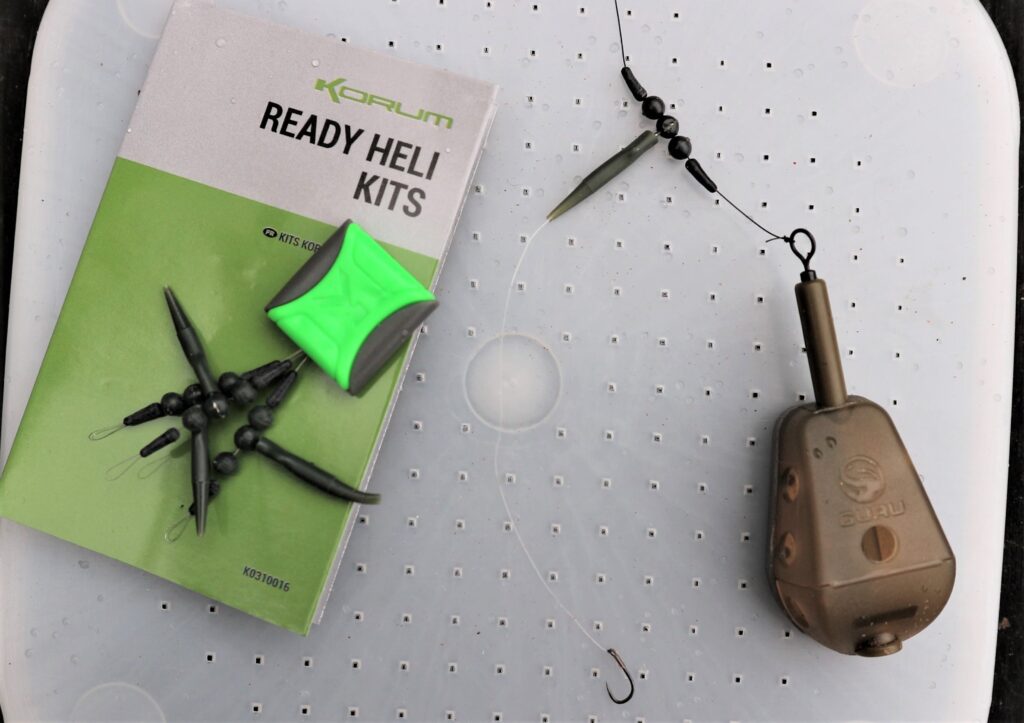

Some successful rigs can be tricky to assemble on the bank, but thankfully not any more when it comes to complicated helicopter set-ups. All the important components can now be purchased ready-installed on looped wires, which allow them to be quickly and neatly transferred onto your main line. After that, a feeder is attached, along with a short hook link and the rig is ready for action. The helicopter method performs best with blockend feeders and maggots, a top way of catching specimen-sized stillwater roach. This type of tackle can also be applied to groundbait feeders, particularly when trying to outwit shy-biting big bream. I have also used the technique with short hooklengths for far bank river chub, where the tangle-free nature of this clever tackle arrangement helps to prevent any wasted long chucks. When casting tight to far-off features, feeders with longer hooklengths often tangle, or the bait gets snaffled by small stuff.










